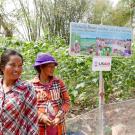Technologies for Horticultural Development fact sheet
Growing vegetables with conservation agriculture
Farmers who grow vegetables on small plots of land often face challenges related to land preparation, weed control and irrigation. At the same time, both their land preparation (because of possible erosion) and pesticide applications (to control weeds) can cause environmental problems. Conservation agriculture is a set of practices that reduces farmer labor and helps the environment while improving soil quality.
How conservation agriculture works
Conservation agriculture typically involves three practices:
- limited soil disturbance (reduced tillage or no-till)
- a layer of vegetative cover on the soil (known as mulch)
- diverse crop rotation
Combined with drip irrigation
Combining these practices with drip irrigation improves water use efficiency, delivering water more directly to the crop roots and decreasing surface evaporation. Drip irrigation works well with conservation agriculture because the mulch layer reduces the need for weeding, thus reducing potential inconvenience and damage to the irrigation equipment. Field trials have found that the combination of conservation agriculture and drip irrigation can mitigate the temporary yield reductions which are often seen upon first adopting conservation agriculture practices.
Benefits of the combination
- Reduce strenuous labor needed for land preparation, irrigation and weeding
- Increase soil organic matter which improves soil structure, moisture infiltration and soil moisture holding capacity
- Reduce soil erosion and herbicide use
- Improve water efficiency, thus reducing the amount of water to pump or cart to the field
Basic costs to implement
- Mulch, including labor to collect and transport
- Drip irrigation tape and connectors
- Water filters for irrigation (depending on local water quality)
- Water container and/or pump for irrigation
These costs are subject to local variation. Identifying appropriate sources of mulch is an ongoing activity.
What’s next? Scaling up
Education: Train farmers and extension workers through field trials and demonstration plots.
Adoption: Work with non-governmental organizations and extension for promotion and awareness. •
Investment: Identify partners and entrepreneurs to make water containers and irrigation equipment available.



